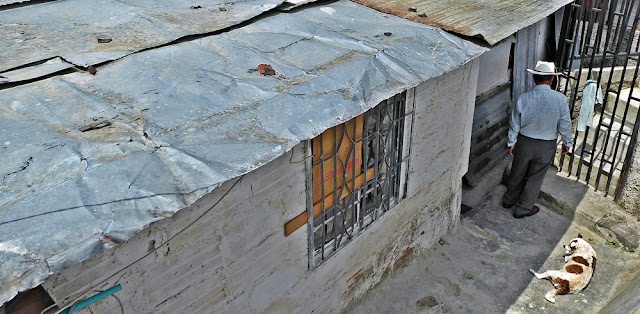The City of Medellin and its People
Friday, February 2, 2018 Medellin
We had a difficult day
yesterday, driving from Manizales to Medellin.
The main road is out. The alternative
for the first half of the trip was a very small, two-lane road in poor repair
up and down the Andean mountains, with miles of switchbacks. The countryside was beautiful:
But the road deteriorated
into a dirt trail in parts:
We arrived in Medellin in
the late afternoon, and our only activity for the day was truly remarkable—an
hour-long talk on the history of the drug cartels in this city and how the city
recovered. It’s a long, complicated story,
but one important factor is the substantial US aid, both financially and with
military advisers. They give us great
credit and say it could not have been done without us.
Today was devoted to learning
about the city and the ordinary people of Medellin, with special attention to
the things which have been done to integrate the poor people into the greater
population, a vital factor in keeping the drug lords away. The city name is pronounced “med-ay-dzhin”
not, as it usually would be in Spanish “med-ay-in.” It’s just a local difference, I guess the way
we in Rochester pronounce Chili “chai-lai”.
Go figure.
We began our day with a
panoramic view of this city of 5 million from up high:
The city is located at
about 5000 feet in a basin surrounded by high mountains, with the poorest of
the poor in shanty towns up the mountains.
Access to the city from the high outskirts used to be by walking literally
hours up and down extremely steep hills.
A key to integration of the poor into the city has been the development
of transportation options. We visited
Communa 13 which used to be the most dangerous section of Medellin. As part of the solution to the drug problem,
a series of outdoor escalators linking the highest part of the neighborhood
with the base of it was built. We went
into the neighborhood, and immediately noticed the extensive murals done by
graffiti artists, sponsored by the city:
We began the walk up to
the first escalator:
On the way, we had a
remarkable exercise. We broke into four
groups, and each group was given 50,000 pesos (about $18) and a short shopping
list, to shop in this market for a couple we were going to visit:
This $72 worth of food
would represent a huge gift, with the minimum wage here being $245/month. The couple we were going to visit is elderly,
and they have no children to help support them.
It truly was informative to see the availability of food and other
goods, and the prices charged for them.
We then went up multiple
escalators to the top of Communa 13:
The neighborhood contains
17,000 people, and currently has electricity, potable water, and a sewer
system, all part of the integration of the neighborhood into Medellin. Here are a couple of views of the
neighborhood from the top:
We then visited the home
of Don Jose, 89, and his wife Virginia, 82:
We were invited into their
home. Here is the living room-kitchen:
And here is the only other
room, the bedroom:
After our visit, we went
down the mountain and drove to a metro station.
There is another neighborhood which has been connected to the city by
way of a cable car system instead of escalators. The cable car station is at one of the metro
stations, and a ticket to ride is valid on any combination of the metro and the
cable cars. We rode the cable cars for a
round trip:
We then took the metro into
downtown. Think of the busiest you’ve
ever seen a New York City street and double it.
Add street vendors, loud music, and a very, very different sense of
personal space, and you’ll get some idea of downtown Medellin on a weekday. Crowded, noisy, busy, hustle-bustle,
shoulder-to-shoulder. It’s
overwhelming. For lunch I had a
traditional dish called Bandeja Paisa which is a bowl of bean soup, and a plate
of multiple sausages, fat bacon, ground beef, a whole fried plantain, a corn
fritter, a large pile of rice covered by a fried egg, and a half of an avocado:
I may not eat again for a
week. It was delicious!! After lunch we walked to Botero Square, named
for the artist/sculptor Fernando Botero. There are about a dozen of his monumental sculptures
around the square, which is in front of a municipal building which looks like a
church:
Our guide then had us see
what was right in front of us but what we had not noticed. Botero Square is the center of legal prostitution
in Medellin. The prostitutes are
registered with the government, medically surveyed periodically, and protected
by the police. He introduced us to a
woman who had been working this square for more than 20 years:
We had the opportunity to
talk with her and ask questions; she was somewhat uncomfortable with the
interaction, as were we.
We then went into the
Museo D’Antiquia where there is a large collection of Botero paintiings, which
are more intriguing and complex than I had realized from only seeing photos of
them. Here’s a Virgin and Child with the
Virgin Mary handing cash with her left hand to Botero himself, who is kneeling
at her feet:
Here’s a version of the
drug lord Pablo Escobar being killed by Colombian and US drug agents on the
roof of a house (which is how he died):
And here is a Christ:
There’s lots more to learn
about this remarkable artist. Some
day.
So, this was a remarkable day
learning about the city and the ordinary people of Medellin.
























Remarkable! Amazing contrasts, like another planet.
ReplyDelete